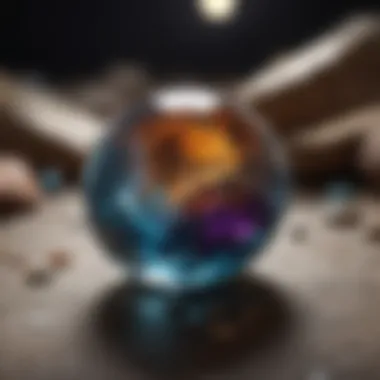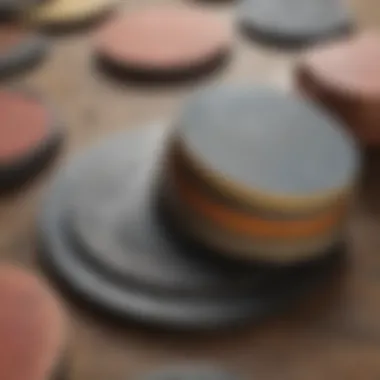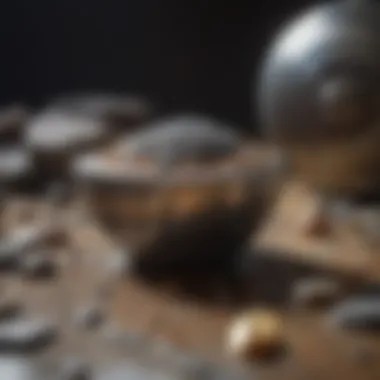Unlocking the Secrets: A Comprehensive Guide to Rock Polishing Kits for Beginners


Rock and Fossil Identification
When delving into the fascinating world of rock and fossil collection, understanding the types of rocks and fossils is paramount. Rocks can range from sedimentary, igneous, to metamorphic, each with distinct characteristics awaiting discovery. Fossils, on the other hand, offer glimpses into ancient lifeforms preserved in stone. As a beginner rock collector, knowing the key characteristics to look for in rocks and fossils sets the foundation for a successful venture. Utilizing tools such as magnifying glasses, hardness testing kits, and UV lights aids in the identification process, ensuring accurate classification and appreciation of geological wonders.
Collecting Tips and Techniques
Discovering rocks and fossils in their natural habitat requires finesse and knowledge. Best practices for collecting involve respecting nature, obtaining necessary permits for excavation on public lands, and adhering to ethical guidelines for specimen removal. Locating prime collecting sites involves research, joining local geology clubs, and connecting with experienced collectors who can offer valuable insights. Safely extracting specimens entails using proper tools like rock hammers, chisels, and safety goggles to avoid accidents and protect the integrity of the finds.
Preservation and Display
Preserving rocks and fossils ensures longevity and maintains their pristine condition for future generations. Employing techniques such as cleaning with soft brushes, sealing with consolidants, and storing in acid-free containers aids in conservation efforts. Proper storage methods involve keeping specimens in stable environments free from moisture and direct sunlight to prevent deterioration. Get creative with display ideas by arranging rocks and fossils in shadow boxes, creating themed exhibits, or using elegant stands to showcase nature's beauty.
Geological Insights
Unlocking the geological secrets embedded in rocks and fossils offers a glimpse into Earth's history. Understanding geological formations and processes sheds light on how rocks are created, transformed, and eroded over time. Delve into the historical significance of rocks and fossils, tracing their importance in shaping scientific discoveries and cultural narratives. Explore notable discoveries in the field, from dinosaur skeletons to rare minerals, that continue to captivate scientists and enthusiasts alike.
Introduction
Rock polishing is a fascinating journey that allows individuals to delve into the world of geological specimen curation. In this article, we will comprehensively explore rock polishing kits tailored specifically for beginners. As novice rock and fossil collectors embark on this exciting venture, understanding the intricacies and nuances of rock polishing kits becomes paramount. By illuminating the essential components, techniques, and best practices, this guide aims to equip beginners with the knowledge and tools necessary to kickstart their journey of transforming rough rocks into polished gems.
Understanding Rock Polishing
Definition of Rock Polishing
Rock polishing, also known as lapidary, is the art of shaping and polishing rocks and minerals to reveal their natural beauty. It involves meticulously grinding, smoothing, and shining raw stones using abrasive techniques and polishing compounds. The key characteristic of rock polishing lies in its ability to turn ordinary rocks into stunning gem-like creations, making it a popular choice among rock enthusiasts. The unique feature of rock polishing is its transformative nature, where rough and unremarkable stones are transformed into exquisite pieces of art. While the process requires patience and precision, the satisfaction of unveiling the hidden beauty of rocks through polishing is a rewarding experience for beginners entering the world of geological specimen curation.
Benefits of Rock Polishing
The benefits of rock polishing extend beyond merely enhancing the aesthetic appeal of rocks. It offers a hands-on experience that fosters a deeper appreciation for geology and the natural world. Engaging in rock polishing promotes creativity and mindfulness, allowing individuals to connect with the earth's geological history on a personal level. Furthermore, polished rocks serve as unique decorative pieces, educational tools, and thoughtful gifts, adding value to one's collection and sharing the wonders of nature with others. The process of rock polishing not only refines the external appearance of rocks but also refines the mind, instilling virtues of patience, precision, and perseverance in beginners.
History of Rock Polishing
Rock polishing has a rich historical significance dating back centuries. Ancient civilizations such as the Egyptians and Greeks practiced lapidary art, using rudimentary tools to shape and polish stones for ornamental and religious purposes. Over time, rock polishing evolved into a revered craft, with lapidaries honing their skills and techniques to produce finely polished gemstones and sculptures. In the modern era, rock polishing has become a popular hobby and educational pursuit, allowing enthusiasts to explore the geological wonders of the earth in their homes. The history of rock polishing reflects humanity's enduring fascination with minerals and gemstones, showcasing the timeless allure of transforming raw rocks into polished treasures.
Essential Components of a Rock Polishing Kit
In the vast world of rock polishing, understanding the essential components of a rock polishing kit is key to achieving excellent results. A rock polishing kit typically consists of several crucial elements that play a vital role in the process of transforming rough rocks into polished gemstones. These components include a tumbler machine, grits and polishing compounds, as well as barrels and drums. Each component serves a specific purpose in the rock polishing journey, contributing to the quality and efficiency of the final outcome.


Tumbler Machine
Types of Tumbler Machines
When considering rock polishing kits, the type of tumbler machine you choose can significantly impact the polishing process. Tumbler machines come in various forms, such as rotary tumblers and vibratory tumblers. Rotary tumblers are ideal for beginners due to their simplicity and versatility, while vibratory tumblers are known for their fast and efficient polishing action. Understanding the characteristics of each type will help you select the most suitable tumbler machine for your needs.
Features to Look for in a Tumbler
Selecting a tumbler machine with the right features is essential for achieving consistent and high-quality results. Key features to consider include the capacity of the tumbler, the materials used in its construction, the motor power, and noise levels. Additionally, look for tumbler machines with adjustable speed settings and reliable warranties. These features ensure optimal performance and durability, making your rock polishing experience more enjoyable and productive.
Grits and Polishing Compounds
Different Types of Grits
Grits play a significant role in the rock polishing process, determining the level of abrasiveness and smoothness of the final polish. Different types of grits, such as silicon carbide and aluminum oxide, offer varying levels of coarseness for grinding and polishing stages. Understanding the characteristics of each grit size will help you achieve desired finishes on your polished rocks, from rough grinding to fine polishing.
Importance of Polishing Compounds
Polishing compounds enhance the luster and shine of polished rocks, providing a final touch to your gemstones. These compounds, made of various mineral oxides and abrasives, help remove scratches and achieve a mirror-like finish on the surface of rocks. Choosing the right polishing compound for the type of rocks you are polishing is crucial to achieving professional-quality results and bringing out the natural beauty of your specimens.
Barrels and Drums
Materials Used in Barrels
The materials used in barrels and drums of rock polishing kits play a crucial role in determining durability and efficiency. Common materials include rubber, plastic, and metal, each offering distinct advantages in terms of wear resistance and noise levels. Opt for barrels made from high-quality materials to ensure longevity and optimal performance during the rock polishing process.
Sizes and Capacities
Choosing the right size and capacity of barrels and drums is essential for accommodating the quantity and size of rocks you intend to polish. Larger barrels are suitable for batch processing multiple rocks simultaneously, while smaller barrels are ideal for individual polishing projects. Consider the dimensions and capacities of barrels to streamline your polishing workflow and achieve consistent results with each batch of rocks.
Choosing the Right Rock Polishing Kit
In the realm of rock polishing, selecting the appropriate kit holds immense significance. The choice of a rock polishing kit serves as the foundation for the entire polishing process, directly impacting the outcome of the polished rocks. In this section, we delve into the critical factors that newcomers must consider when embarking on their rock polishing journey, ensuring that they make informed decisions tailored to their specific needs.
Factors to Consider
Budget Constraints


When it comes to rock polishing, budget constraints play a pivotal role in decision-making. Understanding the financial boundaries within which one operates is essential since rock polishing kits come in a wide range of prices, making it crucial to align the chosen kit with one's budget. Budget constraints determine the quality of the tumbler machine, the variety of grits and polishing compounds, as well as the overall kit features. Balancing cost and quality is key, ensuring that beginners have access to a kit that meets their needs without overspending.
Space Requirements
Space requirements are another vital consideration when selecting a rock polishing kit. The size of the tumbler, barrels, and other components must fit comfortably within the designated space for polishing rocks. Adequate room for operating the tumbler and storing the kit is necessary for a smooth polishing experience. Beginners should assess the available space before purchasing a kit to avoid any constraints or challenges during the polishing process.
Types of Rocks to Polish
The types of rocks one intends to polish are fundamental in choosing the right rock polishing kit. Different rocks have varying hardness levels, requiring specific grits and polishing compounds for optimal results. Beginners must consider the types of rocks they plan to work with to ensure that the kit they select includes the necessary components for polishing those specific rock types. Understanding the characteristics of the rocks will guide novices in selecting a kit tailored to their unique requirements.
Popular Brands and Models
Reviews and Recommendations
Exploring reviews and recommendations from experienced rock polishers aids beginners in making informed decisions. Reviews offer insights into the performance, durability, and ease of use of various kits, helping novices narrow down their options based on real user experiences. Recommendations from seasoned collectors provide valuable guidance, pointing newcomers towards reputable brands and models that deliver consistent results.
Comparison of Top Kits
Comparing the top-rated rock polishing kits in the market enables beginners to evaluate the features, capabilities, and value each kit offers. By conducting a thorough comparison, novices can pinpoint key differences between kits, such as tumbler capacity, barrel materials, and included accessories. This comparative analysis empowers beginners to select a kit that aligns with their preferences and priorities, setting them up for a successful rock polishing journey.
Safety Precautions and Best Practices
In the realm of rock polishing kits for beginners, understanding and adhering to safety precautions and best practices is paramount. Safety measures not only protect individuals but also ensure the longevity of the equipment and the quality of the polished rocks. Delving into this aspect underscores the value of upholding safety standards throughout the rock polishing process, enhancing the overall experience for enthusiasts.
Safety Gear Protective Eyewear
Within the scope of safety gear, emphasis on the utilization of protective eyewear is crucial. Protective eyewear serves as a shield against potential hazards such as flying rock particles or polishing grit. The key characteristic of quality protective eyewear lies in its durability and impact resistance. Opting for reputable brands ensures maximum protection for the eyes during the tumbling process. The unique feature of anti-fog coating enhances visibility, reducing the risk of accidents while enthused beginners explore the art of rock polishing. The advantage of protective eyewear cannot be overstated, making it an indispensable choice for safeguarding vision in this article.
Safety Gear Gloves and Aprons
Another vital component of safety gear in rock polishing kits is the use of gloves and aprons. These items shield the hands and body from potential abrasive materials and chemicals used in the polishing process. The key characteristic of quality gloves and aprons is their thickness and material composition, ensuring a barrier against skin irritation and cuts. Opting for snug-fitting gloves provides dexterity while handling rocks, offering an added layer of protection. The unique feature of adjustable straps in aprons allows for a customizable fit, catering to various body types for enhanced comfort. While gloves and aprons may have limitations in terms of comfort, their advantages in promoting safety and cleanliness make them indispensable accessories for rock polishing beginners in this article.
Basic Polishing Techniques for Beginners
In understanding the intricate world of rock polishing, mastering basic polishing techniques is a fundamental aspect for beginners looking to delve into this captivating hobby. These techniques lay the foundation for achieving superior results and elevating the appearance of rocks and gemstones. By focusing on basic polishing techniques, individuals can enhance their skills and gradually progress to more advanced methods, making it a crucial subject within this guide to rock polishing kits for beginners. The significance of these techniques lies in their ability to transform rough, unpolished rocks into stunning, polished specimens that showcase the inherent beauty of geological wonders. For novices, grasping basic polishing techniques provides a solid starting point towards unlocking the potential of various rocks and minerals, enabling them to curate their collection with finesse.
Preparing Rocks for Polishing


Cleaning and Sorting Rocks
Cleaning and sorting rocks serve as the preliminary steps in the rock polishing journey, setting the stage for a successful polishing process. The process of cleaning rocks involves removing any dirt, debris, or impurities that may be present on the surface, ensuring a clean and smooth base for polishing. Sorting rocks helps in categorizing them based on their size, type, and characteristics, which aids in determining the appropriate polishing techniques and materials to employ. This meticulous process of cleaning and sorting rocks is crucial as it enables beginners to identify the potential of each rock specimen and tailor their polishing approach accordingly. By dedicating time to clean and sort rocks meticulously, enthusiasts lay a solid groundwork for achieving exceptional polishing results, enhancing the overall quality of their rock collection.
Initial Inspection
Conducting an initial inspection of rocks before polishing is a crucial step that allows beginners to assess the condition and characteristics of each rock. During the inspection, individuals can identify any cracks, impurities, or irregularities that may impact the polishing process. This hands-on approach provides valuable insight into the unique features of each rock, helping enthusiasts determine the most suitable polishing techniques and strategies to employ. The initial inspection not only helps in setting realistic expectations regarding the final outcome of the polishing process but also aids in avoiding potential pitfalls or damage to the rocks during polishing. By thoroughly examining rocks before polishing, beginners can make informed decisions and customize their approach to ensure optimal results with each specimen.
Troubleshooting Common Issues
In the intricate world of rock polishing, troubleshooting common issues plays a critical role in ensuring a successful and fulfilling experience for beginners. By addressing potential challenges that may arise during the polishing process, individuals can overcome obstacles and achieve optimal results in their geological specimen curation endeavors. Troubleshooting common issues not only enhances the overall efficiency of rock polishing but also fosters a deeper understanding of the craft, allowing enthusiasts to hone their skills and expertise over time. Within the context of this article, focusing on troubleshooting common issues provides valuable insights into problem-solving techniques, preventive measures, and practical solutions tailored specifically for novice rock and fossil collectors.
Uneven Polishing
One of the most prevalent challenges faced by beginners in rock polishing is the occurrence of uneven polishing, which can affect the final aesthetics and quality of the polished rocks. Understanding the causes and solutions for uneven polishing is paramount in addressing this issue effectively and achieving desirable outcomes in rock curation. By delving into the specific aspects of causes and solutions for uneven polishing, individuals can grasp the underlying factors contributing to this problem and implement strategies to rectify it. Exploring the key characteristics of causes and solutions not only sheds light on the intricacies of rock polishing but also equips beginners with essential knowledge to troubleshoot common issues with confidence. The unique feature of focusing on causes and solutions for uneven polishing lies in its direct applicability to the rock polishing process, offering practical guidance and actionable insights to enhance the overall polishing experience. Understanding the advantages and disadvantages of various solutions for uneven polishing enables individuals to make informed decisions and adopt best practices to optimize their rock polishing efforts in alignment with the overarching goals of this article.
Conclusion
In the final segment of this meticulously crafted guide to rock polishing kits for beginners, it is essential to appreciate the culmination of knowledge and skills acquired throughout the article. Understanding the intricate world of rock polishing is a gateway to immersing oneself in the art of geological specimen curation. The importance of the conclusion lies in synthesizing all the key components, techniques, and safety precautions discussed earlier to empower beginners to embark on their rock polishing journey with confidence.
Final Thoughts
Encouragement for Beginners
Delving into the realm of rock polishing can be an intimidating yet rewarding endeavor for novices. Encouraging beginners to take that first step is crucial in nurturing their passion for geological exploration. The essence of 'Encouragement for Beginners' in this article lies in providing reassurance and motivation to individuals venturing into unfamiliar territory. By instilling a sense of curiosity and perseverance, this aspect serves as a cornerstone for aspiring enthusiasts to overcome challenges and discover the beauty of polished rocks.
Key Characteristic
The key characteristic of 'Encouragement for Beginners' is its ability to instill confidence and ignite a sense of wonder in newcomers to the rock polishing community. By highlighting the exciting prospects and potential growth that lie ahead, this element acts as a guiding light for those taking their first steps in this captivating hobby.
Unique Feature
One unique feature of 'Encouragement for Beginners' is its emphasis on building a supportive network of fellow rock enthusiasts. Through shared experiences and encouragement, beginners can forge connections that enhance their learning journey and foster a sense of belonging within the community. This collaborative spirit not only motivates individuals but also promotes a culture of shared knowledge and camaraderie in the world of rock polishing.
Embracing the Art of Rock Polishing
Embracing the art of rock polishing transcends mere hobbyist interests; it embodies a deep appreciation for the geological wonders that surround us. This aspect of the article underscores the significance of approaching rock polishing not just as a skill to master but as a form of artistic expression and reverence for the natural world. By embracing the artistry inherent in shaping and polishing raw stones, enthusiasts can unlock the transformative power of turning rough rocks into beautiful works of art.
Key Characteristic
The key characteristic of 'Embracing the Art of Rock Polishing' lies in fostering creativity and mindfulness in the rock polishing process. By encouraging practitioners to view each polished stone as a masterpiece in the making, this aspect invites individuals to infuse their unique flair and vision into every rock they polish, creating personalized geological treasures that reflect their creativity and aesthetic sensibilities.
Unique Feature
A standout feature of 'Embracing the Art of Rock Polishing' is its emphasis on the meditative and therapeutic aspects of this craft. Through the act of shaping, smoothing, and polishing rocks, enthusiasts can find solace in the rhythmic motions and transformative journey of turning rough stones into polished gem-like specimens. This immersive experience not only yields visually appealing results but also nourishes the soul, making rock polishing a holistic practice that nurtures both creativity and inner peace.







